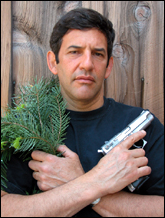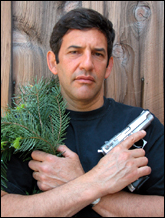
Jordan Fisher Smith.
If you had to guess which federal agents in the U.S. face the greater danger, who would you put your money on: the officers who wage the endless War on Drugs, or the rangers who patrol the green acres of the national parks? Well, it’s the rangers. According to a 2001 study by the Bureau of Justice, nature’s security guards are twice as likely to be assaulted on the job as agents with the Drug Enforcement Administration.
Being a ranger entails more risk than you might imagine. Routine maintenance and rescues can require skiing in avalanche-prone terrain, maneuvering specially equipped aircraft, or paddling class-IV whitewater. In some parks, border disputes and drug trafficking up the ante. And in the case of injury — including animal or even human attack — the nearest help may be miles away.
From the late 1970s until 2000, Jordan Fisher Smith faced these dangers for a chance to protect the nation’s inheritance. He patrolled a series of public lands, including Grand Teton and Sequoia national parks, until the lingering effects of Lyme disease forced him to retire. Smith’s experiences during the last 14 years of his career — working 42,000 acres along the American River canyon in California’s Auburn State Recreation Area — led him to write Nature Noir: A Park Ranger’s Patrol in the Sierra.
The American River canyon is federal land unlike any other. For the last 40 years, it has been slated to be submerged by a 4,000-foot-wide dam. But during endless delays on the dam project, the area has grown into a tangled patch of wildlife — and wild ways. In prose that walks the border between evocative and spare, Smith tells the story of “how people behave in a condemned landscape,” weaving murder and intrigue with the sweet revelation of finding inspiration in a seemingly hopeless place. As a result, Nature Noir becomes a sort of paean to lost causes, or causes that might be lost.
Grist spoke with Smith about the strange saga of the park, his own near-death experiences, and the nature of love in the face of an uncertain future.
Why is the American River park different from, and more dangerous than, other national parks?
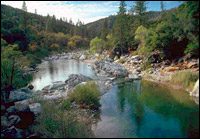
Auburn State Recreation Area.
Photo: California State Parks.
The park is an accident of history. In 1965, the federal government condemned a huge landscape to build Auburn Dam, a great Western dam as tall as the Hoover Dam and [much] wider. In the upstream canyons that were due to be flooded by the dam, the government acquired or condemned 42,000 acres of land and then systematically burned down buildings — ranches, gold mine structures, cabins — to reduce the land to a blank slate. The intent was to finish the dam within a decade, but it ran into all sorts of problems. It happened to exist at a historical moment when the environmental movement came into its own. … By 1970, when the dam [was] under way, it was Earth Day. The environmental movement arrayed itself against the dam. Then it turned out the dam was sitting over fault lines capable of causing earthquakes, which necessitated a redesign that resulted in higher costs.
The story … goes on for decades, to this day. The dam has never been decommissioned, and is still a project on paper. That land has lain under a death sentence for 40 years, but having been depopulated of its occupants in the mid-’60s, it began to go really wild. It [had been] mined and ranched and clear-cut and overgrazed, but under the regime of waiting for its undoing, it began to heal, and animals that used to live on it — mountain lions and black bears — came back. During the ’70s, it was also repopulated by a brand of misanthrope — gold miners, fugitives from the law, squatters living in tents and vehicles. It became a strange, lawless, Wild-West zone. And that’s how I found it in 1986.
How did the National Park Service come to get responsibility for the area?
When these big reservoirs are built, like Lake Powell or Lake Mead, they are usually given to the Park Service to operate as a recreational boating lake. As this place became more lawless, skirmishes broke out, bodies showed up, and people started dumping sofas and washing machines and stolen cars down the walls of the canyons. The Bureau of Reclamation tried calling in the federal marshals to sweep the area, but that didn’t work, because the marshals were not there all the time. So in 1977, the government sent a platoon of park rangers for the specific purpose of getting control of the place. These were people who thought they would spend their lives protecting natural treasures, and instead they end up working 400 to 600 feet beneath the water level of a federal dam. Nature Noir tells the problems they encounter.
Why did you write Nature Noir?
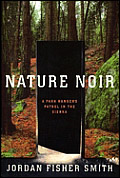
Nature Noir by Jordan
Fisher Smith, Houghton
Mifflin Company, 216
pgs., 2005.
This book is my story, and the story of the [seven] rangers I worked with. It’s the story of an experiment, of being in a place that has really no promise and still promising yourself to it in a committed way. It was a good place to get yourself killed, to get yourself shot, but what we did was give ourselves to the land, knowing that we could not be sure that we could take our grandchildren there and say, “This is where I worked as a young man.”
It is a much better place now. The rangers have built trails there. They have a volunteer group that gives nature walks. It is much safer now — there’s less criminal activity. There are 20 outfitters that lead guided trips down the rapids.
It was rough on us personally, but for the land and for me there has been a big payoff. It was a huge risk to give my heart to a place I didn’t know was going to be there.
So has the dam’s moment passed? Is the American River park here to stay?
Right now there is no budget for the dam … but California is a state with nearly 36 million people, [and it] keeps wanting to grow. And growth in semi-arid places, especially in the south and the Central Valley, takes water. … In a state that needs water, this place will never be safe. Anyplace where you can put a dam in and trap water is never safe. The park is operated by the California Department of Parks and Recreation now, but only under a contract from the U.S. Department of the Interior, Bureau of Reclamation. They are not treating it as a park, and anytime the culture has the political will to build the dam, there will be a dam there.
Why do you think Nature Noir resonates with readers?
I think that what people see in the landscape of the book is a piece of their real world. We environmentalists have a sense that we don’t know what will be here in 50 years. A national park is a pretend landscape that we say is preserved forever, but in the present environmental situation we question whether anything can be preserved forever. If the whole ecology changes, then even if you protect a given landscape carefully it is at risk. So the American River is a perfect model of the world. We cannot predict what will become of this landscape in 10 or 15 years. In the meantime, under a regime of care, much of it is going fabulously wild and healing from the previous insults it suffered.
What surprised you in your position — and what did you learn?
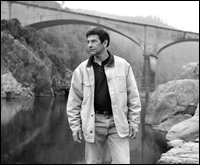
Smith and the American River.
I didn’t know how close I would be to getting myself killed! When I got to this place, it looked so forlorn and hopeless. After I’d driven around for a week with the rangers, I wanted to leave so fast that I planned to transfer as soon as my year was up. Instead, I stayed for the rest of the time I was a ranger.
The experience put to the test everything I believed as a ranger, and as time went on and I kept staying, I think I came to understand that if I couldn’t love this place, what good was it to love a place that was supposedly perfect? This was the place that put my whole land ethic to the test, my whole idea of being a ranger. It was like working with the homeless or drug addicts or trying to rehabilitate juvenile offenders, or working with the aged. If you are caring for someone in a hospice situation, what is that about? It is an act of faith to invest yourself in something that does not promise to give you rewards. That was the great learning for me, and in fact it has given me rewards. My whole life is about this place.
How did your time at American River change you?
My friend Wendell Berry (What Are People For?) said to me that in marriage, as in land, your job is not to find the perfect woman or man or landscape to love … your job in life is to take what you’ve got and make it better. Take the land that is right there, even when it has been abused, even when it is not perfect, even when it is in California, and make it better. …
I tried to be a writer for a long time. When I first got to American River and was working there and also writing, I thought I had been really unlucky to have such bad material. I knew Rick Bass was in Montana, Terry Tempest Williams was in the red-rock canyonlands in Utah, Richard Nelson was on an island off the coast of Alaska — and all I had was a canyon that was supposed to go under a dam sooner or later. Now I consider myself tremendously lucky to have come to this place. So I think the way it has changed me is that I now understand the nature of love, both with land and people. The nature of love is faith. If you really love anybody or anything, it is an act of faith.
Is there anything that could make the work of a ranger less dangerous?
There are lots of measures that could be taken by the government to support the rangers. I started working for the Forest Service in 1973, and my entire career has existed during a period of huge contraction of the budget in parks and wilderness. There are apocryphal stories of seasonal park officers who get posted at the Golden Gate Recreational Area and wind up collecting food stamps because their incomes put them at poverty level. It’s high time the nation started valuing this legacy of the parks. After all, the national parks, the federal wilderness, and the state parks amount to a lifeboat, a Noah’s ark full of … primeval nature. I heard a saying the other day, “The parks and the wilderness are first in the American people’s hearts, but last in their pocketbooks.”
What’s next for you in your writing?
I would be very surprised if my work didn’t continue to have a very strong relationship with nature, because I think that’s the thing that matters at this moment in history. If there is anybody around in 200 years to characterize this particular age in history the way that we talk about the Age of Enlightenment, the Renaissance, or the Industrial Revolution, [it will be characterized as] this huge collision between human culture and nature. … Without a working planet, there is no human life, and my work will continue to reflect that.
